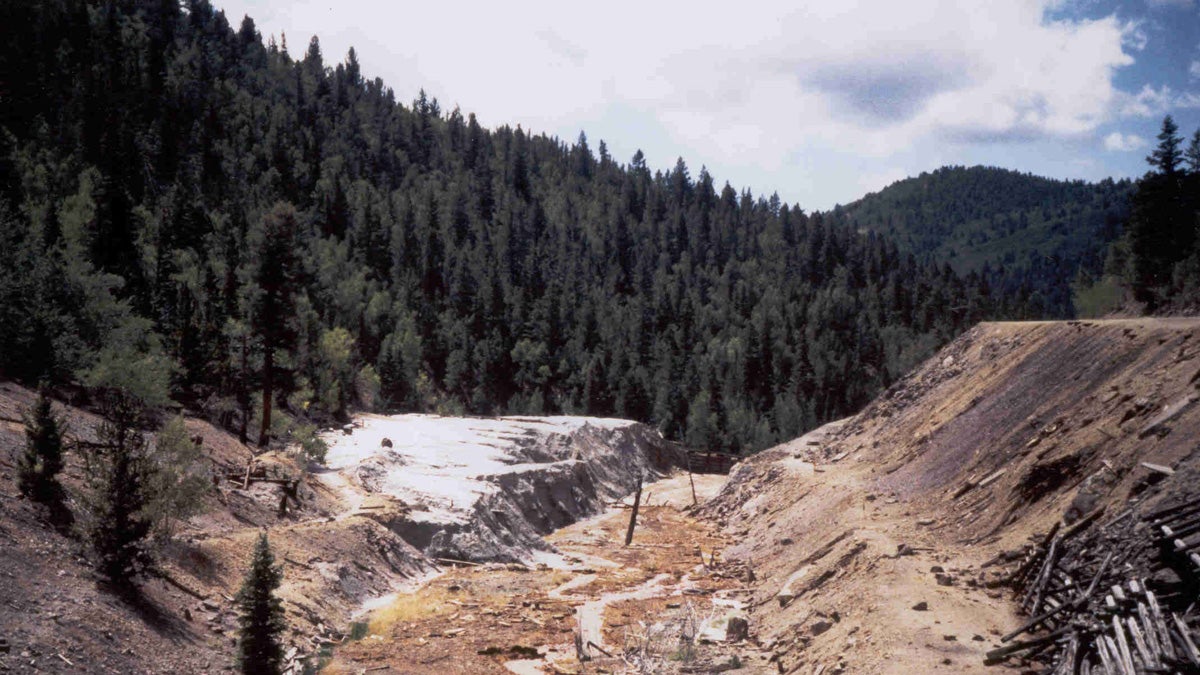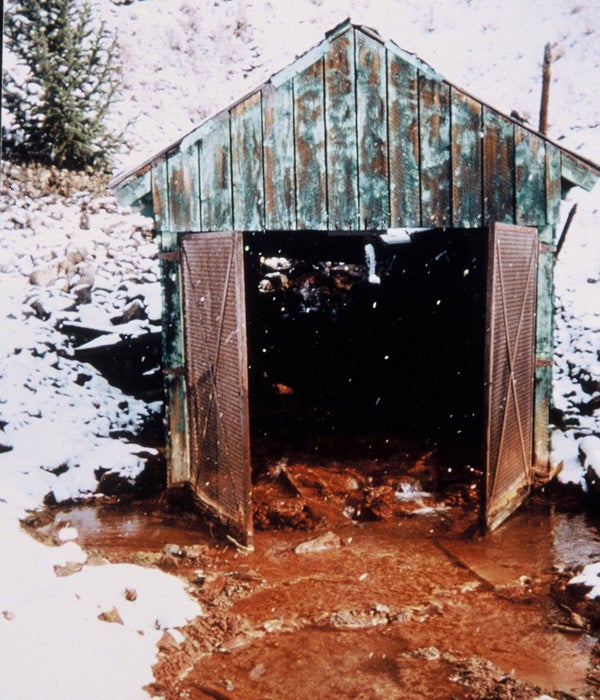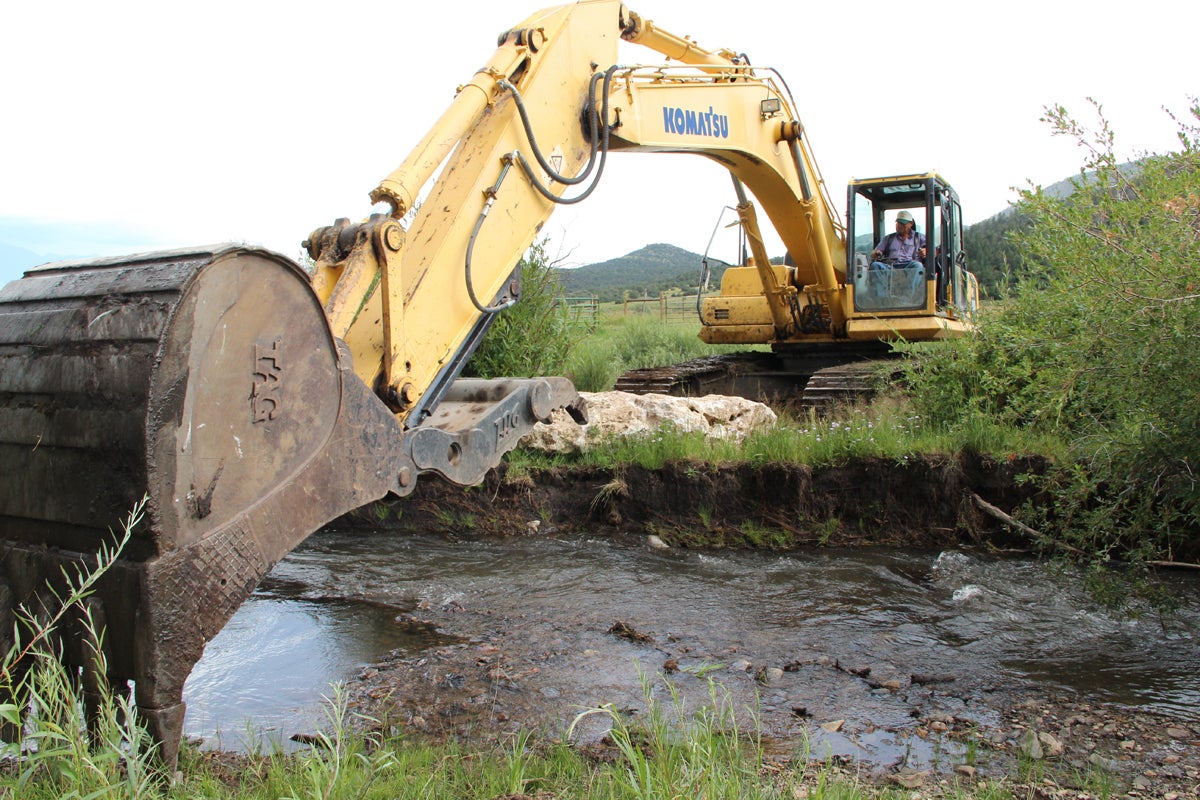How abandoned mines are killing creeks across Colorado
Listen
Mine tailings and water laden with heavy metals spilled out below the Rawley12 mine tunnel on the Rio Grand National Forest
Colorado creek cleanup efforts are revealing the large scale of the problem.
After the Environmental Protection Agency accidentally spilled three million gallons of polluted mine waste into Colorado’s Animas River, it was easy to blame the government.
But even before the spill, mines in Colorado and across the West were leaking toxic materials into thousands of mountain streams. Take Kerber Creek. It runs through a wide valley below the spine of the Continental Divide, about four hours southeast of Denver, through Carol and John Wagner’s ranch.The Wagner’s moved here in 1986, to raise cattle. But when they first arrived, the creek had a problem.”Nothing could live in it,” said Carol Wagner.
At first she didn’t understand why. Then the Wagner’s learned that a mine 15 miles up the valley had spilled. Its tailings and the water pouring from its leaking tunnels were poisoning the creek that ran through their ranch.
Before that spill, the creek would have been jumping with trout and full of aquatic bugs. Jason Willis, who works for Trout Unlimited on mine cleanups across Colorado, says toxic runoff from abandoned mines is killing creeks all over the state and the West.
Cleaning up the creeks
Now, Willis is working on a cleanup of Kerber Creek, at the Wagner ranch. Before that cleanup could happen, though, the leaks from the mines further upstream needed to get cleaned up.
On a sunny late-summer day, Willis takes a high-clearance vehicle up to a site on the Rio Grande National Forest. Driving up, small rocks in piles, a type of mine waste, known as tailings, litter the side of the creek. There’s also a giant abandoned mill, surrounded by piles of waste several stories high.
“[It] kind of sticks out like a sore thumb between aspen trees and pine trees and grass up on the hillslope,” said Willis. “You can imagine a football field full of mine tailings.”
The rocks, which have been processed to remove precious metals like silver and copper, are red, orange, grey and black. The Cocomongo mill and mine here was abandoned in the 1950s. It still stands, a remnant of the mining boom that played a key role in settling Colorado and many other western states.
Just a couple miles over is the Rawley 12 mine, which was responsible for much of the pollution in Kerber Creek, down at Carol Wagner’s ranch. Laura Archuleta, who works on cleanups for the U.S. Fish and Wildlife Service, shows photos of the mine before the cleanup started in the early 1990s. She points to a picture of what looks like a lake of sludge.
“The very first time I was up here was in the late 1990s…that was a very huge holding pond for the water that was draining out of there.”
As water runs over mine waste and tailings, it turns acidic, and picks up heavy metals. The acidity and metals are toxic to animal and plant life, and when the acidic drainage flows downstream, it can effectively kill a waterway.

Acid mine waste drains from the Rawley 12 mine tunnel in the early 1990s. (U.S. Fish and Wildlife Service)
“Lead, zinc, copper, cadmium, a lot of other things on that line, that can be full of iron, said Archuleta. “And so when the chemistry happens, they can release those metals into the water and they can flow downstream.
Signs of life
The work to clean up this mine took decades, and cost millions of dollars. Toxic water was spilling from the old mine tunnel. To plug the leak, cleanup workers had to partially rebuild the tunnel. Then it took hundreds of dump truck loads to remove the tons of mine waste at this site, leftover from mining many years ago.
Now after years of work, there are signs of life. The tunnel is plugged, grass and even some small trees are beginning to grow. There are even a few dandelions.
“Dandelions are actually a good indicator,” said Archuleta. That’s because they won’t grow in metal-enriched soils.
The Rawley 12 mine cleanup worked. And that’s a good thing. Downstream is everything from potato fields to the Rio Grande River, flowing through cities like Albuquerque and El Paso, all the way to the Gulf of Mexico.
The funding challenge
But the cost and effort involved with the mine cleanup was huge. The federal government estimates there are tens of thousands of abandoned mines that could be causing contamination, so many that they are not completely sure of the scale of the problem.
Finding funds to do these cleanups is a big barrier to large scale cleanups, says University of Colorado law professor Mark Squillace. One way to raise more funds would be to require mines on public lands, like national forests, to pay royalties to the federal government.
“You could easily impose a fee on the tonnage that is produced from these mines to fund a program to reclaim hardrock mines,” said Squillace.
That would take a change to the 1872 mining law. In a recent hearing, New Mexico senator Martin Heinrichs (D) called for such a change. Past efforts to do this have all failed to pass, however.
Liability is another issue. Groups like Trout Unlimited often won’t take on big cleanups, because they fear they could be sued under the Clean Water Act. It would also take an update to that law to help so-called good samaritan cleanup groups.
An ongoing effort
After the Rawley 12 mine got cleaned up, Jason Willis and Trout Unlimited were finally able to begin work down at Kerber Creek, at Carol Wagner’s ranch. Beside the creek, an excavator is lifting giant boulders and placing them along the stream bank, “to stabilize the bed,” said Willis.
The heavy equipment also tills in lime to neutralize the soil, and compost to help plants grow. It’s been three years so far, and Carol Wagner said she sees a huge difference.

An excavator works to stabilize the stream bank along Kerber Creek, part of a multi-year restoration project. (Stephanie Paige Ogburn)
“Now there’s trout living here in the creek and a lot of wildlife are here, and it’s just changed everything.”You might be able to call the cleanup here a success story. But it’s one that was two decades in the making. The work on the Wagner’s ranch costs around $200,000 a year, and additional work upstream pushes the project bill near half a million dollars annually. And the effort will likely take a few more years to complete, said Willis.
Multiply that by the tens of thousands of creeks like Kerber that likely need this kind of work, and the message is clear. Cleaning up the West’s mining mess is an effort that will be ongoing for years to come.
WHYY is your source for fact-based, in-depth journalism and information. As a nonprofit organization, we rely on financial support from readers like you. Please give today.



